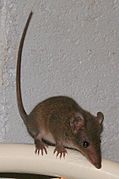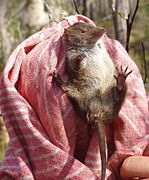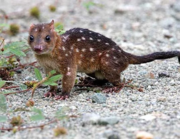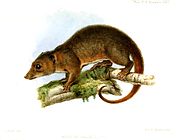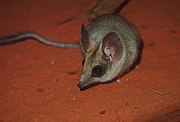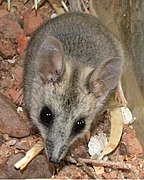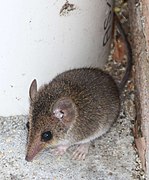List of dasyuromorphs

The seventy-two
Conventions
| Critically Endangered (0 species) | |
| EN | Endangered (5 species) |
|---|---|
| VU | Vulnerable (5 species) |
| NT | Near threatened (11 species) |
| LC | Least concern (47 species) |
| Other categories | |
| DD | Data deficient (3 species) |
| NE | Not evaluated (1 species) |
Conservation status codes listed follow the International Union for Conservation of Nature (IUCN) Red List of Threatened Species. Range maps are provided wherever possible; if a range map is not available, a description of the dasyuromorph's range is provided. Ranges are based on the IUCN Red List for that species unless otherwise noted. All extinct species or subspecies listed alongside extant species went extinct after 1500 CE, and are indicated by a dagger symbol "†".
Classification
The
Family Dasyuridae
- Subfamily Dasyurinae
- Genus Antechinus (antechinuses): ten species
- Genus Dasycercus(mulgaras): two species
- Genus Dasykaluta(little red kaluta): one species
- Genus Dasyuroides(kowari): one species
- Genus Dasyurus(quolls): six species
- Genus Murexia (dasyures): five species
- Genus Myoictis (three-striped dasyures): four species
- Genus Neophascogale(speckled dasyures): one species
- Genus Parantechinus(dibbler): one species
- Genus Phascogale (phascogales): three species
- Genus Phascolosorex(marsupial shrews): two species
- Genus Pseudantechinus(false antechinus): six species
- Genus Sarcophilus (Tasmanian devil): one species
- Subfamily Sminthopsinae
Family
- Genus Myrmecobius(numbat): one species
Family Thylacinidae
- Genus Thylacinus† (thylacine): one species (one extinct)
|
Dasyuromorphs
The following classification is based on the taxonomy described by the reference work Mammal Species of the World (2005), with augmentation by generally accepted proposals made since using molecular phylogenetic analysis, as supported by both the IUCN and the American Society of Mammalogists.[3]
Dasyuridae
Subfamily Dasyurinae
| Common name | Scientific name and subspecies | Range | Size and ecology | IUCN status and estimated population |
|---|---|---|---|---|
| Agile antechinus | A. agilis Dickman, Parnaby, Crowther & King, 1998 |
Southern Australia
|
Size: 6–13 cm (2–5 in) long, plus 6–12 cm (2–5 in) tail[4] Habitat: Forest and shrubland[5] Diet: Arthropods and other invertebrates, as well as small vertebrates[6] |
LC
|
| Atherton antechinus
|
A. godmani (Thomas, 1923) |
Northeastern Australia
|
Size: 9–16 cm (4–6 in) long, plus 9–14 cm (4–6 in) tail[7] Habitat: Forest[8] Diet: Invertebrates, as well as small vertebrates and carrion[6] |
LC
|
| Brown antechinus | A. stuartii Macleay, 1841 |
Eastern Australia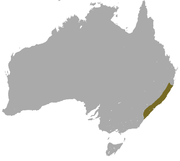
|
Size: 6–19 cm (2–7 in) long, plus 6–16 cm (2–6 in) tail[4] Habitat: Forest[9] Diet: Invertebrates such as beetles, spiders, and cockroaches, as well as vertebrates such as placental mice and plants[10] |
LC
|
| Cinnamon antechinus
|
A. leo Dyck, 1980 |
Northeastern Australia
|
Size: 6–19 cm (2–7 in) long, plus 6–16 cm (2–6 in) tail[4] Habitat: Forest[11] Diet: Invertebrates, as well as small vertebrates[6] |
LC
|
| Dusky antechinus | A. swainsonii (Waterhouse, 1840) |
Southeastern Australia
|
Size: 8–19 cm (3–7 in) long, plus 7–13 cm (3–5 in) tail[4] Habitat: Forest and shrubland[12] Diet: Worms and insects as well as lizards, small birds, fruit, and plants[13] |
LC
|
| Fawn antechinus | A. bellus (Thomas, 1904) |
Northern Australia
|
Size: 6–19 cm (2–7 in) long, plus 6–16 cm (2–6 in) tail[4] Habitat: Forest and savanna[14] Diet: Invertebrates, as well as small vertebrates[6] |
VU
|
| Subtropical antechinus
|
A. subtropicus Dyck, Crowther, 2000 |
Eastern Australia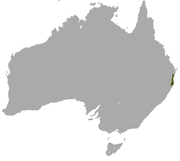
|
Size: 6–19 cm (2–7 in) long, plus 6–16 cm (2–6 in) tail[4] Habitat: Forest and shrubland[15] Diet: Invertebrates, as well as small vertebrates[6] |
LC
|
| Swamp antechinus | A. minimus (Geoffroy, 1803) |
Southern Australia and Tasmania
|
Size: 6–19 cm (2–7 in) long, plus 6–16 cm (2–6 in) tail[4] Habitat: Forest, shrubland, grassland, and inland wetlands[16] Diet: Invertebrates, as well as small vertebrates[6] |
LC
|
| Tropical antechinus
|
A. adustus (Thomas, 1923) |
Northern Australia
|
Size: 7–14 cm (3–6 in) long, plus 6–11 cm (2–4 in) tail[17] Habitat: Forest[18] Diet: Moths, beetles, and other insects, as well as spiders, worms, and small vertebrates such as skinks and frogs[18] |
LC
|
| Yellow-footed antechinus | A. flavipes (Waterhouse, 1838) Two subspecies
|
Southwestern and eastern Australia
|
Size: 8–17 cm (3–7 in) long, plus 6–16 cm (2–6 in) tail[4] Habitat: Forest, savanna, shrubland, and inland wetlands[19] Diet: Insects as well as nectar, mice, and birds[6] |
LC
|
| Common name | Scientific name and subspecies | Range | Size and ecology | IUCN status and estimated population |
|---|---|---|---|---|
| Brush-tailed mulgara | D. blythi (Waite, 1904) |
Western Australia
|
Size: 12–23 cm (5–9 in) long, plus 6–13 cm (2–5 in) tail[20] Habitat: Shrubland, grassland, and desert[21] Diet: Invertebrates, reptiles, and small mammals[21] |
LC
|
| Crest-tailed mulgara | D. cristicauda (Krefft, 1867) |
Central Australia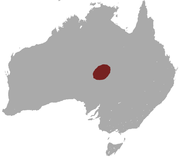
|
Size: 12–22 cm (5–9 in) long, plus 7–13 cm (3–5 in) tail[22] Habitat: Shrubland, grassland, and desert[23] Diet: Insects, arthropods, and small vertebrates[22] |
NT
|
| Common name | Scientific name and subspecies | Range | Size and ecology | IUCN status and estimated population |
|---|---|---|---|---|
| Little red kaluta
|
D. rosamondae (Ride, 1964) |
Western Australia
|
Size: 9–11 cm (4–4 in) long, plus 5–7 cm (2–3 in) tail[24] Habitat: Grassland[25] Diet: Insects, lizards, mice, and other small vertebrates[24] |
LC
|
| Common name | Scientific name and subspecies | Range | Size and ecology | IUCN status and estimated population |
|---|---|---|---|---|
| Kowari | D. byrnei Spencer, 1896 |
Northeastern Australia
|
Size: 13–18 cm (5–7 in) long, plus 11–14 cm (4–6 in) tail[26] Habitat: Shrubland and desert[27] Diet: Invertebrates, as well as rodents, birds, eggs, lizards, and carrion[26] |
VU
|
| Common name | Scientific name and subspecies | Range | Size and ecology | IUCN status and estimated population |
|---|---|---|---|---|
| Bronze quoll
|
D. spartacus Dyck, 1987 |
Southern New Guinea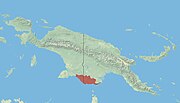
|
Size: 30–38 cm (12–15 in) long, plus 25–29 cm (10–11 in) tail[28] Habitat: Savanna[29] Diet: Insects and small vertebrates[30] |
NT
|
| Eastern quoll | D. viverrinus (Shaw, 1800) |
Tasmania
|
Size: 35–45 cm (14–18 in) long, plus 21–30 cm (8–12 in) tail[31] Habitat: Forest, shrubland, and grassland[32] Diet: Insects, as well as small marsupials, rats, rabbits, mice, carrion, and plants[31] |
EN
|
| New Guinean quoll | D. albopunctatus Schlegel, 1880 |
Northern New Guinea
|
Size: 22–35 cm (9–14 in) long, plus 21–31 cm (8–12 in) tail[33] Habitat: Forest[34] Diet: Insects and small vertebrates[30] |
NT
|
| Northern quoll | D. hallucatus Gould, 1842 |
Northern Australia
|
Size: 12–31 cm (5–12 in) long, plus 12–31 cm (5–12 in) tail[35] Habitat: Forest and shrubland[36] Diet: Insects, as well as small mammals, birds, frogs, reptiles, and fruit[35] |
EN
|
| Tiger quoll | D. maculatus (Kerr, 1792) |
Eastern Australia
|
Size: 35–76 cm (14–30 in) long, plus 34–55 cm (13–22 in) tail[37] Habitat: Forest and shrubland[38] Diet: Greater gliders, rabbits, bandicoots, red-necked pademelons, common ringtail possums, and cuscuses, as well as insects, reptiles, and birds[37] |
NT
|
| Western quoll | D. geoffroii Gould, 1841 |
Southwestern Australia
|
Size: 36–46 cm (14–18 in) long, plus 22–30 cm (9–12 in) tail[39] Habitat: Forest, shrubland, and desert[40] Diet: Small mammals, birds, reptiles, and invertebrates, as well as plants[40] |
NT
|
| Common name | Scientific name and subspecies | Range | Size and ecology | IUCN status and estimated population |
|---|---|---|---|---|
| Black-tailed dasyure
|
M. melanurus (Thomas, 1899) |
New Guinea
|
Size: 9–16 cm (4–6 in) long, plus 10–17 cm (4–7 in) tail[41] Habitat: Forest[42] Diet: Insects and spiders, as well as worms and small vertebrates[41] |
LC
|
| Broad-striped dasyure
|
P. rothschildi Tate, 1938 |
Eastern New Guinea
|
Size: 12–17 cm (5–7 in) long, plus 14–19 cm (6–7 in) tail[43] Habitat: Forest[44] Diet: Invertebrates and small vetebrates, including birds[43] |
NT
|
| Habbema dasyure
|
M. habbema (Tate, Archbold, 1941) |
Central New Guinea
|
Size: 11–13 cm (4–5 in) long, plus 10–16 cm (4–6 in) tail[45] Habitat: Forest and grassland[46] Diet: Insects, worms, and small vertebrates[45] |
LC
|
| Long-nosed dasyure
|
P. naso (Jentink, 1911) |
Central New Guinea
|
Size: 12–20 cm (5–8 in) long, plus 10–18 cm (4–7 in) tail[43] Habitat: Forest[47] Diet: Insects, spiders, and worms[43] |
LC
|
| Short-furred dasyure | M. longicaudata (Schlegel, 1866) |
New Guinea
|
Size: 13–29 cm (5–11 in) long, plus 14–29 cm (6–11 in) tail[48] Habitat: Forest[49] Diet: Insects[48] |
LC
|
| Common name | Scientific name and subspecies | Range | Size and ecology | IUCN status and estimated population |
|---|---|---|---|---|
| Tate's three-striped dasyure
|
M. wavicus Tate, 1947 |
Eastern New Guinea | Size: 16–25 cm (6–10 in) long, plus 15–23 cm (6–9 in) tail[50] Habitat: Forest[51] Diet: Insects and lizards[50] |
DD
|
| Three-striped dasyure | M. melas (Müller, 1840) |
Northern New Guinea
|
Size: 16–25 cm (6–10 in) long, plus 15–23 cm (6–9 in) tail[50] Habitat: Forest[52] Diet: Insects and lizards[50] |
LC
|
| Wallace's dasyure | M. wallacii Gray, 1858 |
Southern New Guinea
|
Size: 16–25 cm (6–10 in) long, plus 15–23 cm (6–9 in) tail[50] Habitat: Forest[53] Diet: Insects and lizards[50] |
LC
|
| Woolley's three-striped dasyure
|
M. leucura Woolley, 2005 |
Eastern New Guinea | Size: 16–25 cm (6–10 in) long, plus 15–23 cm (6–9 in) tail[50] Habitat: Forest[54] Diet: Insects and lizards[50] |
DD
|
| Common name | Scientific name and subspecies | Range | Size and ecology | IUCN status and estimated population |
|---|---|---|---|---|
| Speckled dasyure | N. lorentzi (Jentink, 1911) |
Central New Guinea
|
Size: 16–23 cm (6–9 in) long, plus 17–22 cm (7–9 in) tail[55] Habitat: Forest and grassland[56] Diet: Insects[55] |
LC
|
| Common name | Scientific name and subspecies | Range | Size and ecology | IUCN status and estimated population |
|---|---|---|---|---|
| Dibbler | P. apicalis (Gray, 1842) |
Southwestern Australia
|
Size: 14–15 cm (6 in) long, plus 9–12 cm (4–5 in) tail[24] Habitat: Shrubland[57] Diet: Invertebrates, as well as plants[57] |
EN
|
| Common name | Scientific name and subspecies | Range | Size and ecology | IUCN status and estimated population |
|---|---|---|---|---|
| Brush-tailed phascogale | P. tapoatafa (Meyer, 1793) |
Northern, western, and eastern Australia (in green and yellow)
|
Size: 16–23 cm (6–9 in) long, plus 17–22 cm (7–9 in) tail[58] Habitat: Forest and savanna[59] Diet: Invertebrates, as well as nectar[59] |
NT
|
| Red-tailed phascogale | P. calura Gould, 1844 |
Southwestern Australia
|
Size: 9–13 cm (4–5 in) long, plus 11–15 cm (4–6 in) tail[60] Habitat: Forest, savanna, and shrubland[61] Diet: Insects and spiders, as well as small mammals, birds, and lizards[60] |
NT
|
| Northern brush-tailed phascogale
|
P. pirata Thomas, 1904 |
Northern Australia (current range in dark green)
|
Size: 15–21 cm (6–8 in) long, plus 18–21 cm (7–8 in) tail[60] Habitat: Forest[62] Diet: Insects and spiders, as well as small mammals, birds, and lizards[60] |
VU
|
| Common name | Scientific name and subspecies | Range | Size and ecology | IUCN status and estimated population |
|---|---|---|---|---|
| Narrow-striped marsupial shrew | P. dorsalis (Peters, Doria, 1876) Three subspecies
|
Central New Guinea
|
Size: 13–17 cm (5–7 in) long, plus 11–16 cm (4–6 in) tail[63] Habitat: Forest[64] Diet: Insects and arthropods, as well as small vertebrates[65] |
LC
|
| Red-bellied marsupial shrew | P. doriae (Thomas, 1886) |
Western New Guinea
|
Size: 11–23 cm (4–9 in) long, plus 11–20 cm (4–8 in) tail[63] Habitat: Forest[66] Diet: Believed to be insects and arthropods, as well as small vertebrates[65] |
LC
|
| Common name | Scientific name and subspecies | Range | Size and ecology | IUCN status and estimated population |
|---|---|---|---|---|
| Alexandria false antechinus
|
P. mimulus (Thomas, 1906) |
Central Australia
|
Size: 6–12 cm (2–5 in) long, plus 5–13 cm (2–5 in) tail[67] Habitat: Savanna, shrubland, grassland, and rocky areas[68] Diet: Insects[67] |
NT
|
| Fat-tailed false antechinus
|
P. macdonnellensis (Spencer, 1896) |
Central Australia
|
Size: 7–11 cm (3–4 in) long, plus 6–9 cm (2–4 in) tail[69] Habitat: Savanna, shrubland, rocky areas, and desert[70] Diet: Insects, as well as other invertebrates and rodents[69] |
LC
|
| Ningbing false antechinus
|
P. ningbing Kitchener, 1988 |
Northern Australia
|
Size: 6–12 cm (2–5 in) long, plus 5–13 cm (2–5 in) tail[67] Habitat: Forest, savanna, shrubland, and rocky areas[71] Diet: Insects[67] |
LC
|
| Rory Cooper's false antechinus
|
P. roryi Cooper, Aplin, Adams, 2000 |
Northwestern Australia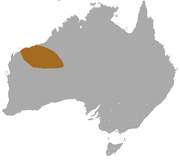
|
Size: 6–12 cm (2–5 in) long, plus 5–13 cm (2–5 in) tail[67] Habitat: Desert and rocky areas[72] Diet: Insects[67] |
LC
|
| Sandstone false antechinus
|
P. bilarni ( Johnson , 1954)
|
Northern Australia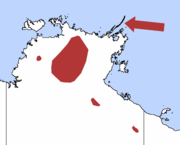
|
Size: 6–12 cm (2–5 in) long, plus 5–13 cm (2–5 in) tail[67] Habitat: Forest, savanna, and rocky areas[73] Diet: Insects[67] |
LC
|
| Woolley's false antechinus
|
P. woolleyae Kitchener, 1988 |
Western Australia
|
Size: 6–12 cm (2–5 in) long, plus 5–13 cm (2–5 in) tail[67] Habitat: Desert, rocky areas, and shrubland[74] Diet: Insects[67] |
LC
|
| Common name | Scientific name and subspecies | Range | Size and ecology | IUCN status and estimated population |
|---|---|---|---|---|
| Tasmanian devil | S. harrisii (Boitard, 1841) Two subspecies
|
Tasmania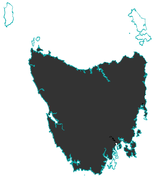
|
Size: 52–80 cm (20–31 in) long, plus 23–30 cm (9–12 in) tail[75] Habitat: Forest, shrubland, grassland, and non-aquatic caves and subterranean habitats[76] Diet: Carrion, as well as insects, larvae, snakes, and plants[75] |
EN
|
Subfamily Sminthopsinae
| Common name | Scientific name and subspecies | Range | Size and ecology | IUCN status and estimated population |
|---|---|---|---|---|
| Kultarr | A. laniger (Gould, 1856) |
Central Australia
|
Size: 7–10 cm (3–4 in) long, plus 10–15 cm (4–6 in) tail[77] Habitat: Savanna, shrubland, grassland, and desert[78] Diet: Spiders, cockroaches, and crickets[79] |
LC
|
| Common name | Scientific name and subspecies | Range | Size and ecology | IUCN status and estimated population |
|---|---|---|---|---|
| Pilbara ningaui
|
N. timealeyi Archer, 1975 |
Northwestern Australia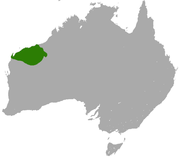
|
Size: 4–8 cm (2–3 in) long, plus 5–10 cm (2–4 in) tail[80] Habitat: Grassland, rocky areas, and desert[81] Diet: Insects, other invertebrates, and possibly small vertebrates[80] |
LC
|
| Southern ningaui | N. yvonnae Kitchener, Stoddart, Henry, 1983 |
Southern Australia
|
Size: 4–6 cm (2 in) long, plus 4–6 cm (2 in) tail[82] Habitat: Grassland and shrubland[83] Diet: Insects and arthropods, as well as reptiles[82] |
LC
|
| Wongai ningaui
|
N. ridei Archer, 1975 |
Central Australia
|
Size: 4–8 cm (2–3 in) long, plus 5–10 cm (2–4 in) tail[80] Habitat: Savanna, shrubland, and grassland[84] Diet: Insects, other invertebrates, and possibly small vertebrates[80] |
LC
|
| Common name | Scientific name and subspecies | Range | Size and ecology | IUCN status and estimated population |
|---|---|---|---|---|
| Common planigale | P. maculata (Gould, 1851) Two subspecies
|
Northern and eastern Australia
|
Size: 5–10 cm (2–4 in) long, plus 4–9 cm (2–4 in) tail[85] Habitat: Forest, grassland, inland wetlands, and rocky areas[86] Diet: Insects, spiders, small lizards, and small mammals[87] |
LC
|
| Long-tailed planigale
|
P. ingrami (Thomas, 1906) Three subspecies
|
Northern and central Australia
|
Size: 5–10 cm (2–4 in) long, plus 4–9 cm (2–4 in) tail[85] Habitat: Savanna and grassland[88] Diet: Invertebrates, as well as small vertebrates[89] |
LC
|
| Narrow-nosed planigale | P. tenuirostris Troughton, 1928 |
Central eastern Australia
|
Size: 5–10 cm (2–4 in) long, plus 4–9 cm (2–4 in) tail[85] Habitat: Shrubland and grassland[90] Diet: Insects and arthropods, as well as small lizards[91] |
LC
|
| New Guinean planigale
|
P. novaeguineae Tate, Archbold, 1941 |
Southern New Guinea
|
Size: 5–10 cm (2–4 in) long, plus 4–9 cm (2–4 in) tail[85] Habitat: Savanna and grassland[92] Diet: Insects, spiders, small lizards, and small mammals[87] |
LC
|
| Paucident planigale | P. gilesi Aitken, 1972 |
Central eastern Australia
|
Size: 5–10 cm (2–4 in) long, plus 4–9 cm (2–4 in) tail[85] Habitat: Shrubland and grassland[93] Diet: Insects, spiders, small lizards, and small mammals[87] |
LC
|
| Common name | Scientific name and subspecies | Range | Size and ecology | IUCN status and estimated population |
|---|---|---|---|---|
| Carpentarian dunnart | S. butleri Archer, 1979 |
Northern Australia
|
Size: 4–14 cm (2–6 in) long, plus 4–13 cm (2–5 in) tail[94] Habitat: Forest and shrubland[95] Diet: Insects, as well as small vertebrates such as lizards and mice[96] |
VU
|
| Chestnut dunnart
|
S. archeri Dyck, 1986 |
Northern Australia and southern New Guinea
|
Size: 4–14 cm (2–6 in) long, plus 4–13 cm (2–5 in) tail[94] Habitat: Forest and savanna[97] Diet: Insects, as well as small vertebrates such as lizards and mice[96] |
DD
|
| Fat-tailed dunnart | S. crassicaudata (Gould, 1844) |
Australia
|
Size: 6–11 cm (2–4 in) long, plus 5–12 cm (2–5 in) tail[98] Habitat: Savanna, shrubland, grassland, and desert[99] Diet: Grasshoppers, moths, and beetles[98] |
LC
|
| Gilbert's dunnart | S. gilberti Kitchener, Stoddart, Henry, 1984 |
Southwestern Australia
|
Size: 4–14 cm (2–6 in) long, plus 4–13 cm (2–5 in) tail[94] Habitat: Forest and shrubland[100] Diet: Insects, as well as small vertebrates such as lizards and mice[96] |
LC
|
| Grey-bellied dunnart
|
S. griseoventer Kitchener, Stoddart, Henry, 1984 |
Southwestern Australia
|
Size: 4–14 cm (2–6 in) long, plus 4–13 cm (2–5 in) tail[94] Habitat: Forest, shrubland, and inland wetlands[101] Diet: Insects, as well as small vertebrates such as lizards and mice[96] |
LC
|
| Hairy-footed dunnart
|
S. hirtipes Thomas, 1898 |
Western central Australia
|
Size: 4–14 cm (2–6 in) long, plus 4–13 cm (2–5 in) tail[94] Habitat: Forest, savanna, shrubland, and grassland[102] Diet: Insects, as well as small vertebrates such as lizards and mice[96] |
LC
|
| Julia Creek dunnart
|
S. douglasi Archer, 1979 |
Northeastern Australia
|
Size: 4–14 cm (2–6 in) long, plus 4–13 cm (2–5 in) tail[94] Habitat: Savanna, shrubland, and grassland[103] Diet: Insects, as well as small vertebrates such as lizards and mice[96] |
NT
|
| Kakadu dunnart
|
S. bindi Dyck, Woinarski & Press, 1994 |
Northern Australia
|
Size: 4–14 cm (2–6 in) long, plus 4–13 cm (2–5 in) tail[94] Habitat: Forest, savanna, and grassland[104] Diet: Insects, as well as small vertebrates such as lizards and mice[96] |
NT
|
| Lesser hairy-footed dunnart | S. youngsoni McKenzie, Archer, 1982 |
Western and central Australia
|
Size: 4–14 cm (2–6 in) long, plus 4–13 cm (2–5 in) tail[94] Habitat: Shrubland, grassland, and desert[105] Diet: Insects, as well as small vertebrates such as lizards and mice[96] |
LC
|
| Little long-tailed dunnart | S. dolichura Kitchener, Stoddart, Henry, 1984 |
Southwestern Australia
|
Size: 4–14 cm (2–6 in) long, plus 4–13 cm (2–5 in) tail[94] Habitat: Forest, savanna, shrubland, and grassland[106] Diet: Insects, as well as small vertebrates such as lizards and mice[96] |
LC
|
| Long-tailed dunnart
|
S. longicaudata Spencer, 1909 |
Western Australia
|
Size: 8–10 cm (3–4 in) long, plus 18–21 cm (7–8 in) tail[107] Habitat: Shrubland, grassland, and rocky areas[108] Diet: Insects and arthropods, as well as lizards, mice, and other small vertebrates[107] |
LC
|
| Ooldea dunnart
|
S. ooldea Troughton, 1965 |
Western central Australia
|
Size: 4–14 cm (2–6 in) long, plus 4–13 cm (2–5 in) tail[94] Habitat: Savanna, shrubland, grassland, and desert[109] Diet: Insects, as well as small vertebrates such as lizards and mice[96] |
LC
|
| Red-cheeked dunnart | S. virginiae de Tarragon, 1847 Three subspecies
|
Northern Australia and southern New Guinea
|
Size: 4–14 cm (2–6 in) long, plus 4–13 cm (2–5 in) tail[94] Habitat: Savanna, grassland, and inland wetlands[110] Diet: Insects, as well as small vertebrates such as lizards and mice[96] |
LC
|
| Sandhill dunnart | S. psammophila Spencer, 1895 |
Southern Australia
|
Size: 4–14 cm (2–6 in) long, plus 4–13 cm (2–5 in) tail[94] Habitat: Shrubland and grassland[111] Diet: Wide variety of small to medium-sized invertebrates[111] |
VU
|
| Slender-tailed dunnart | S. murina (Waterhouse, 1838) |
Eastern Australia
|
Size: 4–14 cm (2–6 in) long, plus 4–13 cm (2–5 in) tail[94] Habitat: Forest, savanna, and shrubland[112] Diet: Insects, as well as small vertebrates such as lizards and mice[96] |
LC
|
| Sooty dunnart
|
S. fuliginosus (Gould, 1852) |
Southwestern Australia
|
Size: 4–14 cm (2–6 in) long, plus 4–13 cm (2–5 in) tail[94] Habitat: Forest and savanna[96] Diet: Insects, as well as small vertebrates such as lizards and mice[96] |
NE
|
| Stripe-faced dunnart | S. macroura (Gould, 1845) |
Australia
|
Size: 7–12 cm (3–5 in) long, plus 5–13 cm (2–5 in) tail[113] Habitat: Savanna, shrubland, grassland, and desert[114] Diet: Insects, as well as small vertebrates[113] |
LC
|
| White-footed dunnart | S. leucopus (Gray, 1842) |
Northern and southern Australia and Tasmania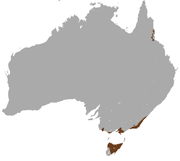
|
Size: 4–14 cm (2–6 in) long, plus 4–13 cm (2–5 in) tail[94] Habitat: Forest, savanna, shrubland, and grassland[115] Diet: Insects, as well as small vertebrates such as lizards and mice[96] |
LC
|
| White-tailed dunnart
|
S. granulipes Troughton, 1932 |
Southwestern Australia
|
Size: 4–14 cm (2–6 in) long, plus 4–13 cm (2–5 in) tail[94] Habitat: Shrubland[116] Diet: Insects, as well as small vertebrates such as lizards and mice[96] |
LC
|
Myrmecobiidae
| Common name | Scientific name and subspecies | Range | Size and ecology | IUCN status and estimated population |
|---|---|---|---|---|
| Numbat | M. fasciatus Waterhouse, 1836 Two subspecies
|
Scattered southwestern and southern Australia
|
Size: 17–29 cm (7–11 in) long, plus 12–21 cm (5–8 in) tail[117] Habitat: Forest, savanna, shrubland, and desert[118] Diet: Termites[117] |
EN
|
Thylacinidae
| Common name | Scientific name and subspecies | Range | Size and ecology | IUCN status and estimated population |
|---|---|---|---|---|
| Thylacine† | T. cynocephalus (Harris, 1810) |
Tasmania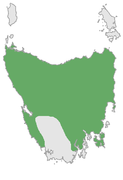
|
Size: 123–195 cm (48–77 in) long, plus 50–66 cm (20–26 in) tail[119] Habitat: Forest and grassland[120] Diet: Mammals such as wallabies, potoroos, bettongs, and livestock[119] |
EX
|
References
- ^ "Fossilworks: Dasyuromorphia". Paleobiology Database. University of Wisconsin–Madison. Retrieved December 15, 2022.
- PMID 29202687.
- ^ Wilson, Reeder, pp. 23–37
- ^ a b c d e f g h Nowak, p. 141
- ^ .
- ^ a b c d e f g Nowak, p. 143
- ^ Turner, p. 34
- ^ .
- ^ .
- ^ Secord, Ross (2000). "Antechinus stuartii". Animal Diversity Web. University of Michigan. Retrieved November 25, 2022.
- ^ .
- ^ .
- ^ Bates, Jeremy (2002). "Antechinus swainsonii". Animal Diversity Web. University of Michigan. Retrieved December 17, 2022.
- ^ .
- ^ .
- ^ .
- ^ Turner, p. 47
- ^ .
- ^ .
- ^ Nowak, p. 155
- ^ .
- ^ a b Nocon, Wojtek (2022). "Dasycercus cristicauda". Animal Diversity Web. University of Michigan. Retrieved November 25, 2022.
- ^ .
- ^ a b c Nowak, p. 150
- ^ .
- ^ a b DeRubeis, Alyssa (2012). "Dasyuroides byrnei". Animal Diversity Web. University of Michigan. Retrieved November 25, 2022.
- ^ .
- ^ Nowak, p. 168
- ^ .
- ^ a b Nowak, p. 162
- ^ a b Cruz, Tracy Dela (2002). "Dasyurus viverrinus". Animal Diversity Web. University of Michigan. Retrieved November 25, 2022.
- ^ .
- ^ Nowak, p. 168
- ^ .
- ^ a b Black, Jenna (2013). "Dasyurus hallucatus". Animal Diversity Web. University of Michigan. Retrieved November 25, 2022.
- ^ .
- ^ a b Verjinski, Stephanie (2013). "Dasyurus maculatus". Animal Diversity Web. University of Michigan. Retrieved November 25, 2022.
- ^ .
- ^ Leung, York Fei (2002). "Dasyurus geoffroii". Animal Diversity Web. University of Michigan. Retrieved November 25, 2022.
- ^ .
- ^ a b Nowak, p. 139
- ^ .
- ^ a b c d Nowak, p. 138
- ^ .
- ^ a b Nowak, pp. 133–134
- ^ .
- ^ .
- ^ a b Nowak, p. 136
- ^ .
- ^ a b c d e f g h Nowak, p. 148
- ^ .
- ^ .
- ^ .
- ^ .
- ^ a b Nowak, p. 160
- ^ .
- ^ .
- ^ Bugby, Christoph (2001). "Phascogale tapoatafa". Animal Diversity Web. University of Michigan. Retrieved December 17, 2022.
- ^ .
- ^ a b c d Nowak, p. 131
- ^ .
- ^ .
- ^ a b Nowak, p. 158
- ^ .
- ^ a b Baker; Dickman, ch. New Guinean fauna
- ^ .
- ^ a b c d e f g h i j Nowak, p. 153
- ^ .
- ^ a b Wozniak, Christopher (2021). "Pseudantechinus macdonnellensis". Animal Diversity Web. University of Michigan. Retrieved November 25, 2022.
- ^ .
- ^ .
- ^ .
- ^ .
- ^ .
- ^ a b Dewey, Tanya; Fahey, Bridget; Kinder, Almaz (2001). "Sarcophilus harrisii". Animal Diversity Web. University of Michigan. Retrieved November 25, 2022.
- ^ .
- ^ Nowak, p. 119
- ^ .
- ^ Beck, Everett (2012). "Antechinomys laniger". Animal Diversity Web. University of Michigan. Retrieved December 17, 2022.
- ^ a b c d Nowak, p. 128–129
- ^ .
- ^ a b Stephenson, Francesca (2010). "Ningaui yvonnae". Animal Diversity Web. University of Michigan. Retrieved November 25, 2022.
- ^ .
- ^ .
- ^ a b c d e Nowak, p. 116
- ^ .
- ^ a b c Nowak, p. 117
- ^ .
- ^ Olson, Kristen (2008). "Planigale ingrami". Animal Diversity Web. University of Michigan. Retrieved November 25, 2022.
- ^ .
- ^ Reuter, Bradley (2002). "Planigale tenuirostris". Animal Diversity Web. University of Michigan. Retrieved November 25, 2022.
- ^ .
- ^ .
- ^ a b c d e f g h i j k l m n o p Nowak, p. 123
- ^ .
- ^ a b c d e f g h i j k l m n o p Nowak, p. 124
- ^ .
- ^ a b Shefferly, Nancy (2022). "Sminthopsis crassicaudata". Animal Diversity Web. University of Michigan. Retrieved November 25, 2022.
- ^ .
- ^ .
- ^ .
- ^ .
- ^ .
- ^ .
- ^ .
- ^ .
- ^ a b Lundrigan, Barbara; Girvin, Melinda (2000). "Sminthopsis longicaudata". Animal Diversity Web. University of Michigan. Retrieved November 25, 2022.
- ^ .
- ^ .
- ^ .
- ^ .
- ^ .
- ^ a b Lundrigan, Barbara; Harris, Julie (2000). "Sminthopsis macroura". Animal Diversity Web. University of Michigan. Retrieved November 25, 2022.
- ^ .
- ^ .
- ^ .
- ^ a b de, Angelique; Riva, la (2013). "Myrmecobius fasciatus". Animal Diversity Web. University of Michigan. Retrieved November 25, 2022.
- ^ .
- ^ a b Treu, Paul (2013). "Thylacinus cynocephalus". Animal Diversity Web. University of Michigan. Retrieved November 25, 2022.
- ^ .
Sources
- Baker, Andrew; Dickman, Chris (2018). Secret Lives of Carnivorous Marsupials. ISBN 978-1-4863-0516-2.
- Nowak, Ronald M. (2018). Walker's Mammals of the World. Vol. Monotremes, Marsupials, Afrotherians, Xenarthrans, and Sundatherians. ISBN 978-1-4214-2468-2.
- Turner, Jim (2004). Mammals of Australia. ISBN 978-954642198-2.
- Groves, Colin P. (2005). ISBN 978-0-8018-8221-0.


